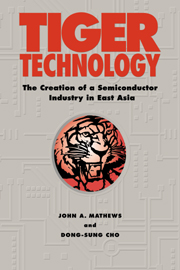Book contents
- Frontmatter
- Contents
- List of Figures
- List of Tables
- Preface
- Abbreviations
- Introduction
- Part I The ‘Real’ East Asian Miracle
- 1 Tiger Chips: The Rise of East Asia in the Global Semiconductor Industry
- 2 Technology Leverage as Latecomer Strategy
- Part II National Institutional Pathways
- Part III The Technology Leverage Strategy
- Appendix I Exchange Rates: 1975–97
- Appendix II Chronolog
- Glossary
- Bibliography
- Index
2 - Technology Leverage as Latecomer Strategy
Published online by Cambridge University Press: 09 October 2009
- Frontmatter
- Contents
- List of Figures
- List of Tables
- Preface
- Abbreviations
- Introduction
- Part I The ‘Real’ East Asian Miracle
- 1 Tiger Chips: The Rise of East Asia in the Global Semiconductor Industry
- 2 Technology Leverage as Latecomer Strategy
- Part II National Institutional Pathways
- Part III The Technology Leverage Strategy
- Appendix I Exchange Rates: 1975–97
- Appendix II Chronolog
- Glossary
- Bibliography
- Index
Summary
Attempts to understand the phenomenon of high-technology industrialisation in East Asia have foundered on the apparent contradictions involved when viewed from the dominant Western perspective. It appeared that Japan, and then Korea and Taiwan, were creating hightechnology companies and industries with minimal research and development expenditures, with little evidence of skilled engineering talent, and with minimal investment in brands and marketing outlets. All this contributed to a view that their efforts were superficial at best or ‘cheating’ at worst.
The problem was that these perspectives were not attuned to the special characteristics of industrialisation by catch-up. Such a process clearly involves a very different set of strategies from those developed in the nineteenth and twentieth centuries by Western industrialising countries. Alice Amsden captured the essence of the shift in her phrase ‘industrialisation by learning’, using it to contrast the experience of new industries in NIEs such as Korea and Taiwan in such sectors as steel, shipbuilding or electronics, with previous phases of industrialisation by ‘invention’ (the case of Britain in the eighteenth century) and by ‘innovation’ (the cases of Germany and the US in the nineteenth century). Amsden argues that the East Asian industrialisation experience is essentially a process of catch-up, in which replication of industrial techniques is achieved through ‘learning’, that is, through accelerated acquisition and adaptation of product and process technologies. Thus it is the institutions of ‘economic learning’ which turn out to be the passport to success in these endeavours, rather than the institutions of conventional R&D.
- Type
- Chapter
- Information
- Tiger TechnologyThe Creation of a Semiconductor Industry in East Asia, pp. 71 - 102Publisher: Cambridge University PressPrint publication year: 2000



